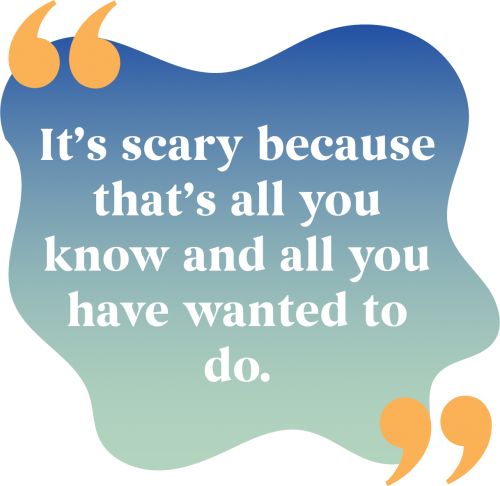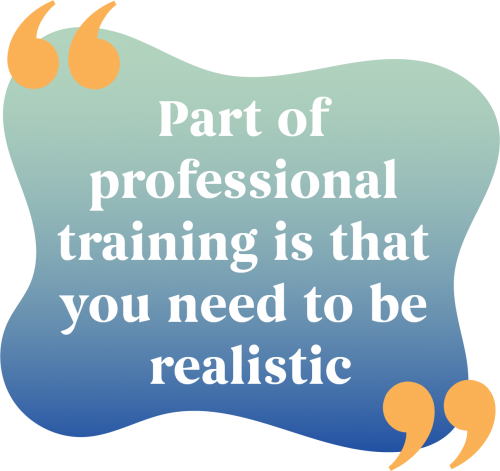For many, burnout within their given field is considered inevitable. But can education systems teach us to be healthier in our work practices?
Words by Jack Wise
Illustrations by Jaime Strand
EVEN WHEN she was little, Nishat Chowdhury watched and surrounded herself with the news. She was always fascinated by the way Peter Mansbridge, former anchor of CBC’s The National, told and presented stories. Journalists like Mansbridge helped Chowdhury realize that she wanted to pursue reporting herself. It’s what drove her to apply for Ryerson’s School of Journalism—one of Canada’s top journalism programs. But when she applied, she had never considered what journalism looked like behind the cameras.
Chowdhury was quickly introduced to the challenges that came with being a journalist. Occupational burnout was frequently mentioned as being a huge problem. In one of her very first journalism classes, her lab instructor warned the class of what to expect in the industry. Her instructor said the long hours, unpredictability of work and pressure to constantly have new pitches came together to make life outside the newsroom overrun by stress.
“There’s always this constant pressure,” Chowdhury remembers realizing.
After hearing from so many professional journalists who opened up about burnout, the first-year student isn’t sure if she’s ready to face the field-specific harms to her mental health. Hearing industry veterans speak about the unpredictability of getting work in freelance roles opened her eyes to the stresses of the journalism industry. It even brought her to question if she’s cut out for the line of work. But considering how much she still wants to be a journalist, she’s not sure if there’s any way of avoiding the burnout that comes with pursuing the career of her dreams.
“It’s scary because that’s all you know and all you have wanted to do.”
The World Health Organization recognized burnout in 2019 as an official medical diagnosis, classifying it as an “occupational phenomenon.” Symptoms often manifest as feelings of exhaustion, cynicism and distancing from one’s job.
Some students can experience burnout before they even graduate. A lack of discussion on occupational burnout in university settings may leave students “blind-sided,” says Corinne Hart, associate professor at the Daphne Cockwell School of Nursing. She says without having proactive strategies for coping, students won’t be able to recognize burnout when it happens.
Since they’re often not taught to recognize or prepare for the symptoms of burnout in school, students can feel as though the issue lies in their own abilities, and as Hart points out, they’re more likely to quit. Because of this, some Ryerson students pursuing their dream careers feel they’re being set up to fail.

UST ENTERING HIS second year, mechanical engineering student Stephen Chavez did some research on what working in the engineering industry is like. Chavez aspires to enter the mechatronics stream, which combines mechanical engineering, electrical engineering and programming.
His findings disheartened him. What he came across were reports of low compensation, poor treatment and highly intensive work—all things that seemed to be a part of the job description.
Even before entering the field, engineering students like Chavez face the harsh reality of burnout.
The Eye previously reported that stress in engineering programs isn’t just widespread, but also seen as a symbol of status.
In a study of 207 engineering undergraduate students from Utah State University, over 53 per cent of students were not happy with the caliber of their academic advising. Some students even left their engineering programs entirely—feeling there wasn’t enough awareness to prepare them for heavy workloads or enough time to seek academic counselling.

Lacking support from their faculty on how to cope now or later in their professional lives, Chavez feels many of his peers overlook the issue of burnout amidst their already packed schedules. His friends are noticeably more exhausted and distant from school and life during exam seasons, literally too busy to address their own wellbeing.
“You’re not informed about [burnout] as much as I think they should be informing you,” he says.
Hart says the issue stems from an idealized picture of what a job might look like, perpetrated by both industries and universities that gloss over the possibility of burnout. “In the companies and schools, [they] have a bit of a shiny version of whatever your profession is going to be,” she says.
“Part of professional training is that you need to be realistic about the chosen profession and know how to deal with the challenges you’re going to face.”
According to a study from the Journal of Cross-Cultural Psychology, teaching students how to perform effectively within their boundaries over a modelled archetype in one’s profession can greatly reduce the chance of occupational burnout.
What appealed to to Chavez about his program choice was the flexibility it offers to go into many different fields.
“I can always do something different with my life,” he says, noting he could switch up his profession in order to avoid burnout.
While some have a choice in avoiding burnout, many do not have that luxury. In a 2007 Personnel Review study examining work-life balance in the face of job dissatisfaction, researchers found many people stay with an employer because they can’t find anything better, or perceive negative consequences of leaving their line of work.

HE WEEK AFTER the Toronto van attack in April 2018, Global News editor Maham Abedi remembers how her employers brought in a counsellor to speak with reporters. Small steps like this have been taken in Abedi’s workplace to mitigate stress and burnout, in addition to other initiatives like the establishment of a wellness room.
Since graduating from Ryerson’s School of Journalism in 2014 and becoming a news editor at Global News, Abedi sees how much awareness of burnout in the newsroom has grown.
When she first stepped into the newsroom, no one even mentioned the term—discussing the concept was looked down on at the time.
Abedi says she quickly learned that journalists were supposed to have a thick skin no matter what. “You would suck it up and you would move on,” she says.
During her time as an instructor last semester, she saw the value in discussing burnout with her students before they begin working in newsrooms. If the discussion does not happen until one enters the workforce, Abedi says there will be the added stressors of age, background and experience when starting the burnout conversation.
Still, Abedi notes how important it is that her colleagues are opening up about their experiences more than before. While these conversations on burnout are headed in the right direction, she feels it’s most important to provide tangible coverage and support for mental health.

A research report from the Mental Health Commission of Canada examined the progress of 40 companies in their implementation of an outlined standard for psychological health in the workplace. The standard proposed by the organization seeks to establish mental health services for employees to address their own concerns while having the workplace recognize the importance of mental wellness.
Over the three-year study from 2014 to 2017, it found that 66 per cent of the organizations promoted mental health awareness while 70 per cent started to offer access to mental health programs for employees. According to the Organisation for Economic Co-operation and Development (OECD), 69 per cent of people with mental health complaints reported having problems in job performance as compared to the 26 per cent who didn’t struggle with mental health issues. Addressing this via workplace specific amendments to labour laws that include obligatory psychosocial risk prevention might be the first step, the study says.
Drawing attention to better employment outcomes and consideration of workers with mental health issues such as burnout will improve quality of life, as Fit Mind, Fit Job from the OECD says. Through effective government policy and reform, ensuring access to mental health resources will greatly reduce mental health related stressors, while also boosting productivity.
Hart says it’s the program’s responsibility to facilitate discourse on campus to prepare students for what they may face beyond university career. Such conversations could be the catalyst for workers’ mental health.
“In any kind of professional program, one would expect that part of it, is talking to students about the challenges of working in that profession and to prepare people to practice within that profession.”

FTER ATTENDING SOME of the events her program puts on to bring greater attention to mindfulness in the journalism industry, Nishat Chowdhury realized there’s a disconnect between discourse on campuses and industry action.
The events make for good discussion within the program, however, that doesn’t begin to tackle the widespread problem in the industry itself. Chowdhury feels it normalizes burnout with an “it is what it is,” attitude, instead of challenging the inevitability of the problem.
While panels and events at university offer a space to learn from and speak to professionals in the industry, Chowdhury mentions it doesn’t solve the problem, as the conversation surrounding the issue isn’t brought to the attention of news companies.
“Don’t see people’s mistakes as an excuse to fire them or let them go,” she says. “Know that if you give people rest they can come back and work harder—they just need a break.”











Leave a Reply